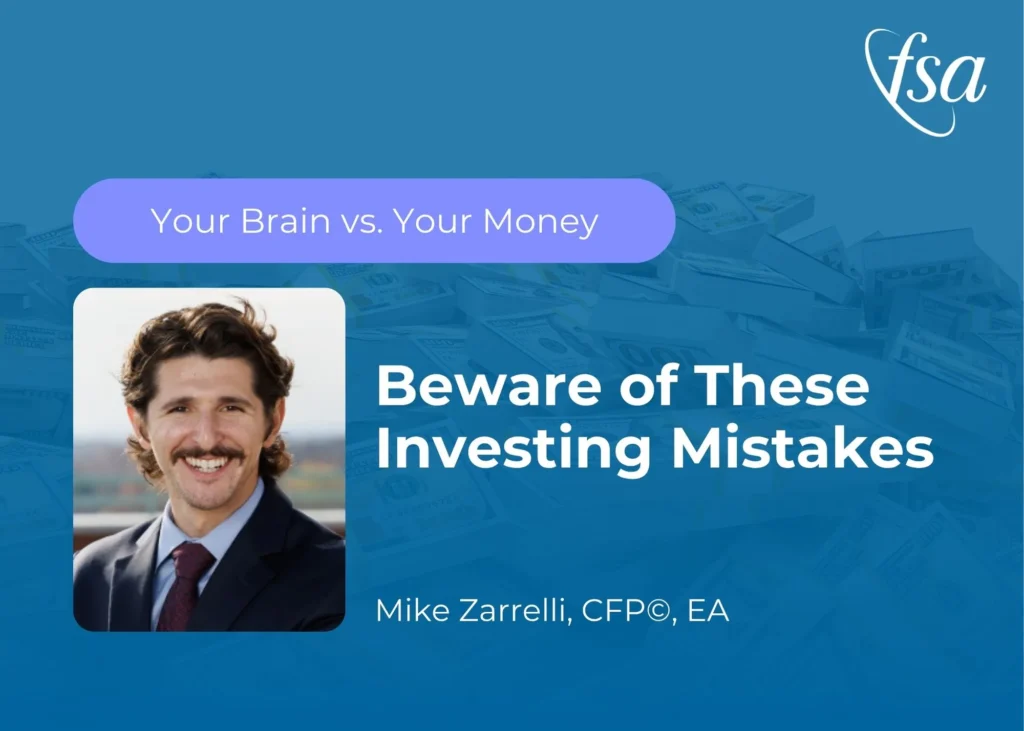Welcome to this edition of Money Matters with FSA, where we provide insights to help you navigate financial decisions with confidence. I’m Mike Zarrelli, a Certified Financial Planner®, and today we’re tackling a topic that affects even the smartest, most successful people, including financial advisors like myself.
One nasty financial mistake can erase years of smart decisions with your money. And the worst part? Most people don’t even see it coming. Because it’s not a math problem, it’s your brain versus your money.
We’re not robots; we’re human. And being human means we’re all susceptible to behavioral biases that can derail our financial plans. Let’s break down three behavioral biases that can cost you dearly, and more importantly, how to avoid them.
Bias #1: Loss Aversion – When “Playing It Safe” Costs You More
Studies show that the pain of loss is actually double the impact of the joy of gain. This phenomenon is why market drops can feel gut-wrenching, especially when you’re watching your portfolio shrink during a bear market.
The Real-World Impact: Remember the 2008 financial crisis? While it was understandably traumatic, many investors moved all their money into money market funds and never looked back. Here’s the problem: money markets might feel safe in the moment, but historically, they barely keep up with inflation. Over the long run, staying in cash likely cost those investors more in lost returns than the bear market ever would—especially given the 10-15 year bull run that followed.
The Lesson: Avoiding the pain of loss can feel safe in the moment, but sometimes the smartest move is sticking to your plan and doing nothing at all. This is where having a strategy like the FSA Safety Net® becomes invaluable—it helps protect against major losses while keeping you invested for long-term growth.
Bias #2: Anchoring – When Past Numbers Hold You Hostage
Anchoring happens when we latch onto a number, even if it’s totally irrelevant to what’s happening right now. We see this all the time with our clients.
Example 1: The Million-Dollar Anchor Let’s say your 401(k) reaches $1 million—a huge accomplishment! But that milestone becomes a mental anchor. The next time the market dips 10%, instead of celebrating your growth over the last five to ten years, you focus on how your account is “down” to $900,000.
Example 2: The Stock Price Trap A client buys a stock at $70, but it falls to $40. Because they’re anchored to that $70 purchase price, we hear: “I’m just going to wait until it comes back up to $70, then I’ll sell.” Here’s the thing—that $70 is arbitrary. The market doesn’t care what price you paid. It’s about earnings, fundamentals, and other valuation factors.
The Lesson: The market doesn’t care what price you paid for a stock or what milestone you just hit in your 401(k). While it’s important to celebrate wins, the only question that matters is: what’s the best decision going forward for you and your family? We help clients take the long view and focus on the forest, not the trees.
Bias #3: Confirmation Bias – Seeking Information That Confirms What We Want to Believe
This one’s particularly sneaky. We naturally seek out information and commentary that supports our personal beliefs, then dismiss anything that challenges those beliefs.
The Bull vs. Bear Example: Right now, there are thousands of articles about why you should be bullish, and simultaneously, thousands about why you should be bearish. The truth? There’s some validity to both perspectives. In most situations, there are both opportunities and risks on the horizon.
The Lesson: This isn’t about being optimistic or pessimistic—it’s about staying open to new information, even when it challenges your beliefs. It’s about getting second opinions to make sure you’re thinking clearly before making major decisions.
Why Smart People Fall Into These Traps
To be honest, it’s because our brains were built for survival, not investing. That’s why having a plan matters. When you have a game plan for any situation, it becomes much easier to avoid these behavioral biases and stick to your strategy.
The FSA Approach: Planning Prevents Poor Performance
At FSA Wealth Partners, we partner with clients to make smart money moves and avoid six-figure mistakes on their journey to building wealth. Our proprietary FSA Safety Net® strategy is designed specifically to help clients navigate market volatility while avoiding the emotional decision-making that often leads to costly mistakes.
Here’s how we help:
- Active Monitoring: Our team of four investment professionals consistently monitors your portfolio, so you don’t have to make emotional decisions in the heat of the moment
- Systematic Risk Management: The FSA Safety Net® helps protect against major losses while keeping you positioned for long-term growth
- Comprehensive Planning: We look at your complete financial picture to develop strategies that align with your goals, not market emotions
The Bottom Line
Understanding these behavioral biases is the first step toward avoiding them. But having a systematic approach—like the FSA Safety Net®—and working with advisors who understand human psychology can make the difference between costly emotional decisions and steady progress toward your financial goals.
Which behavioral bias do you find yourself falling into most often? The key is recognizing these patterns and having systems in place to help you stay on track.
Ready to build a behavioral bias-proof investment strategy?
Contact us at (301) 949-7300 or questions@fsawealthpartners.com to learn how the FSA Safety Net® can help protect your wealth from both market volatility and emotional decision-making.
Stay informed by subscribing to our Money Matters with FSA series for expert financial guidance.
FSA’s current written Disclosure Brochure and Privacy Notice, discussing our advisory services and fees, is available at www.fsawealthpartners.com/disclosures or by calling (301) 949-7300.
See you in the next edition of Money Matters with FSA.




